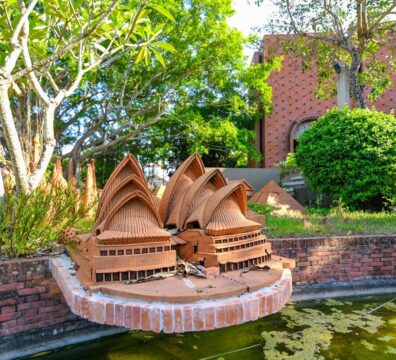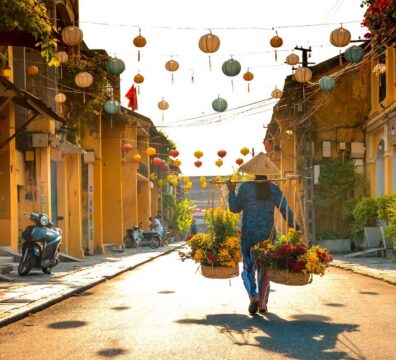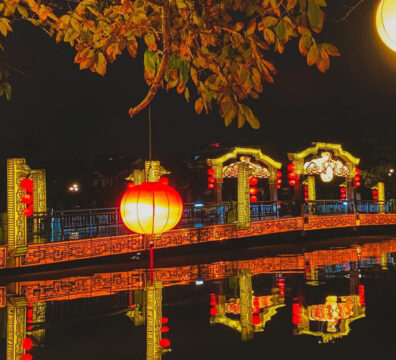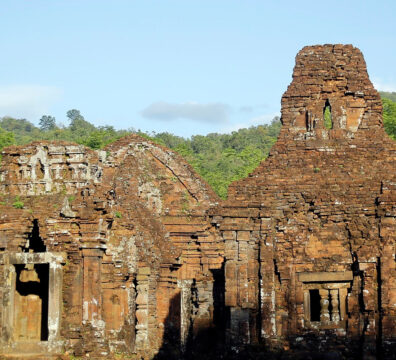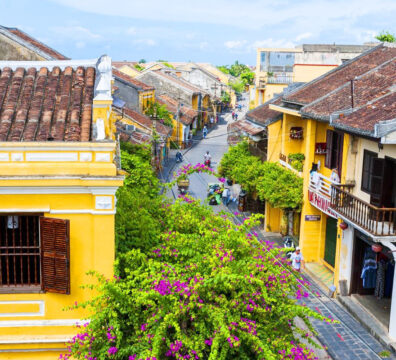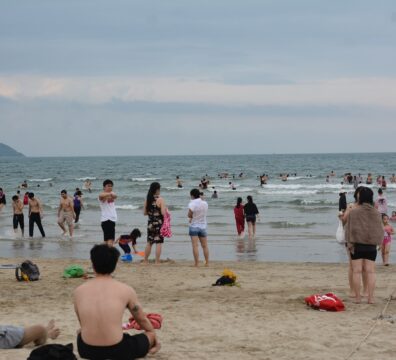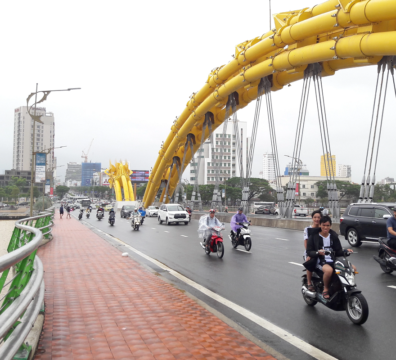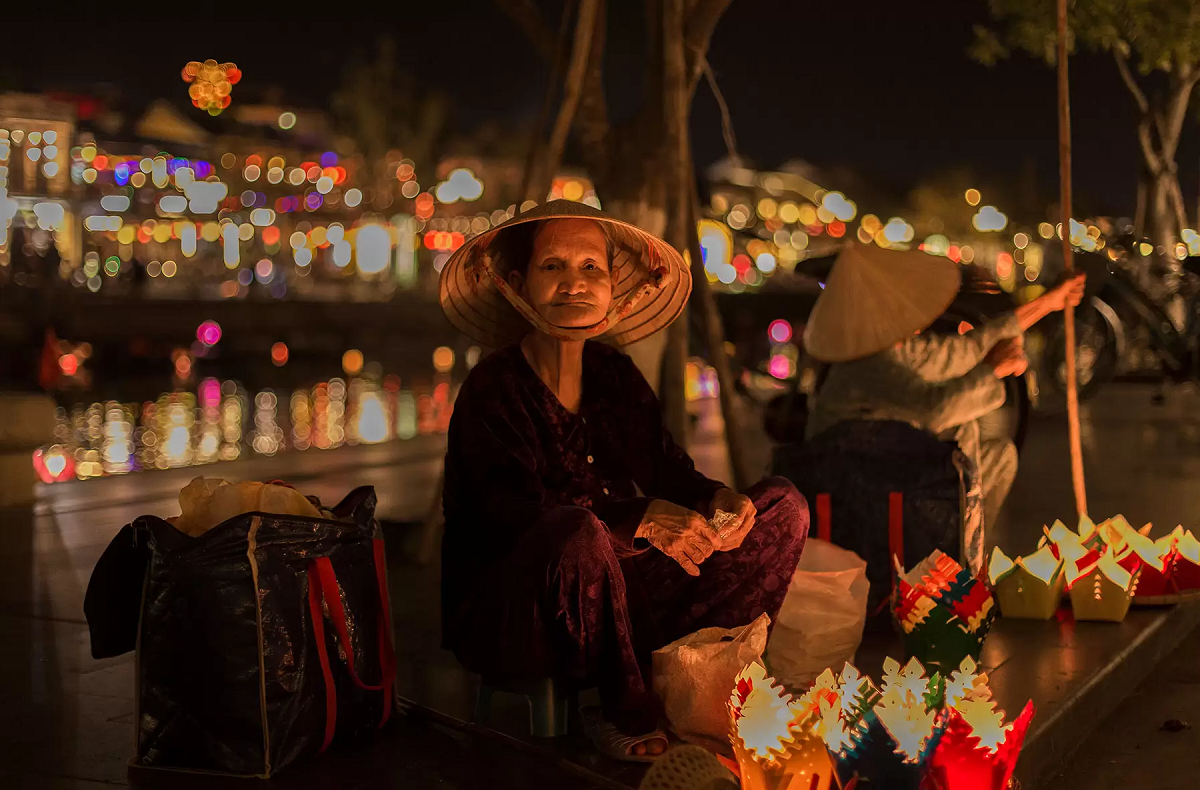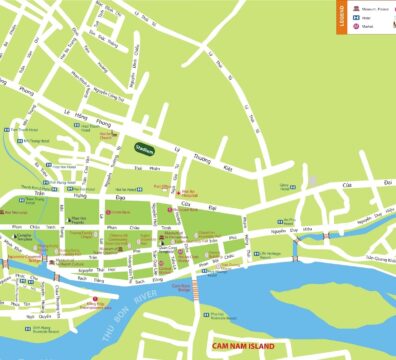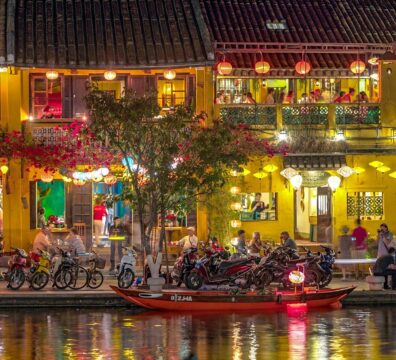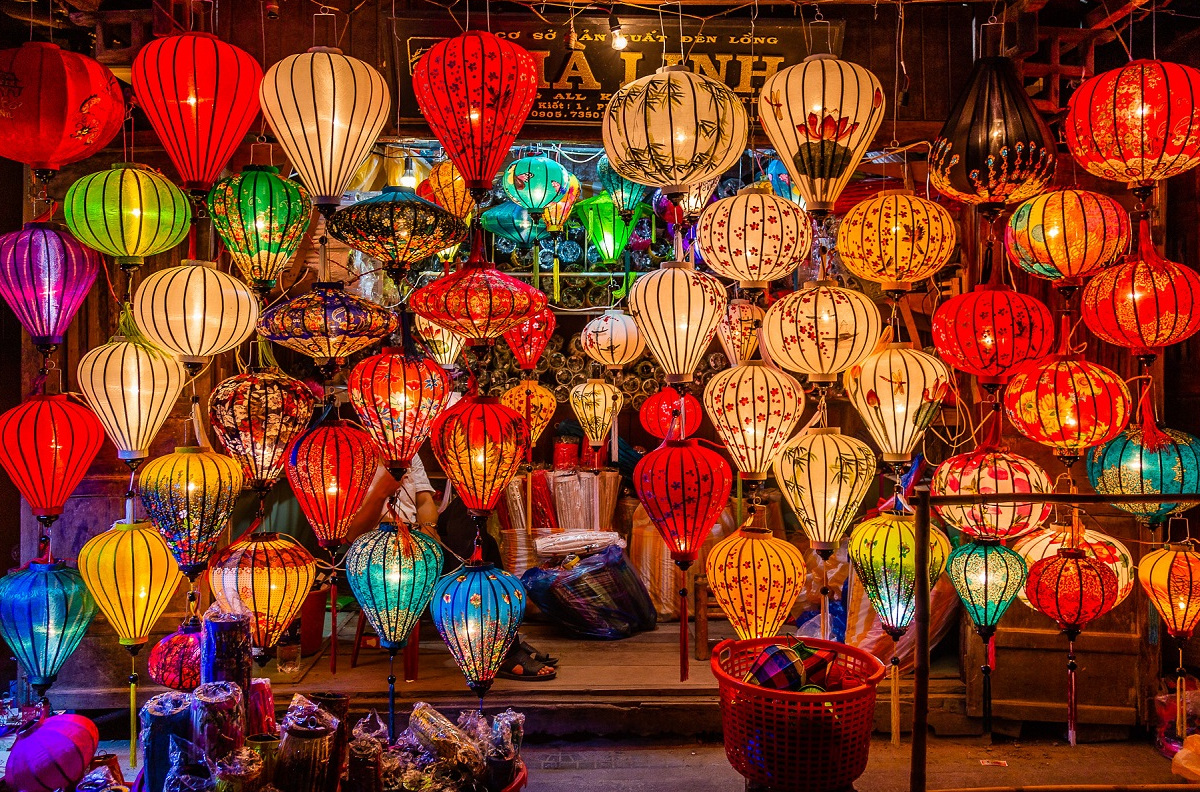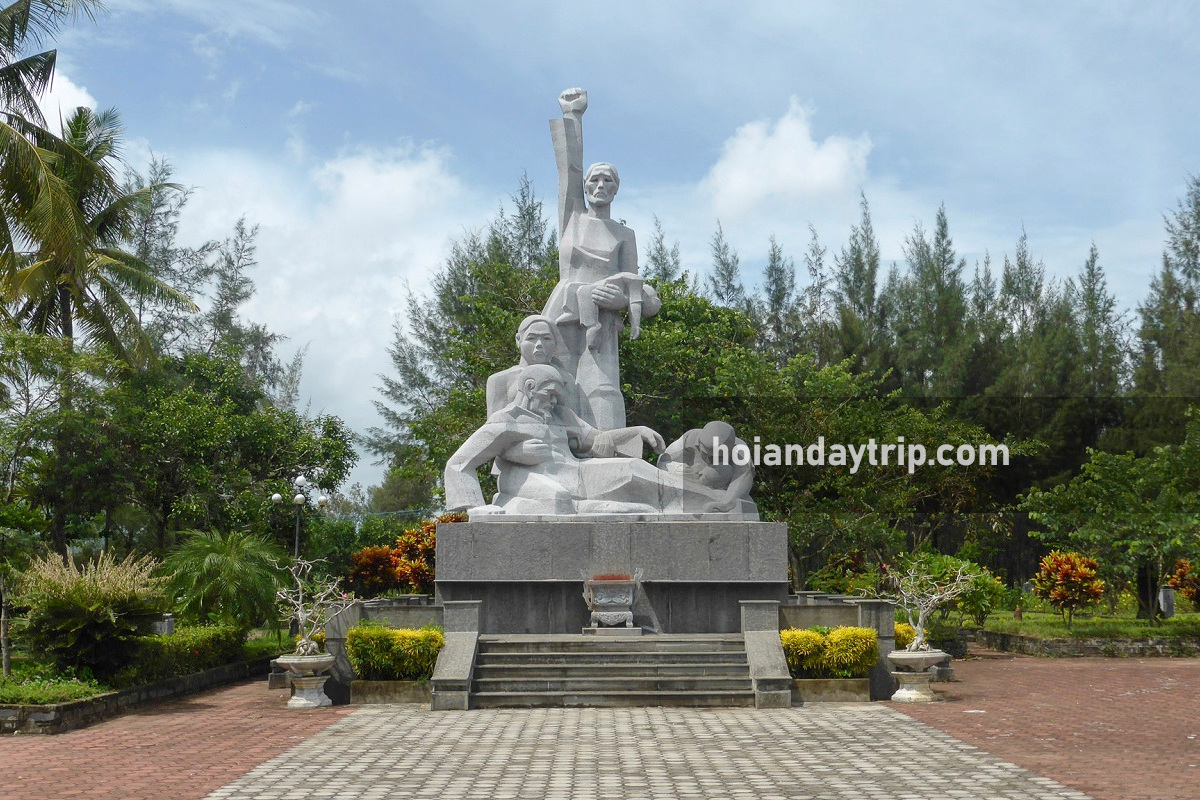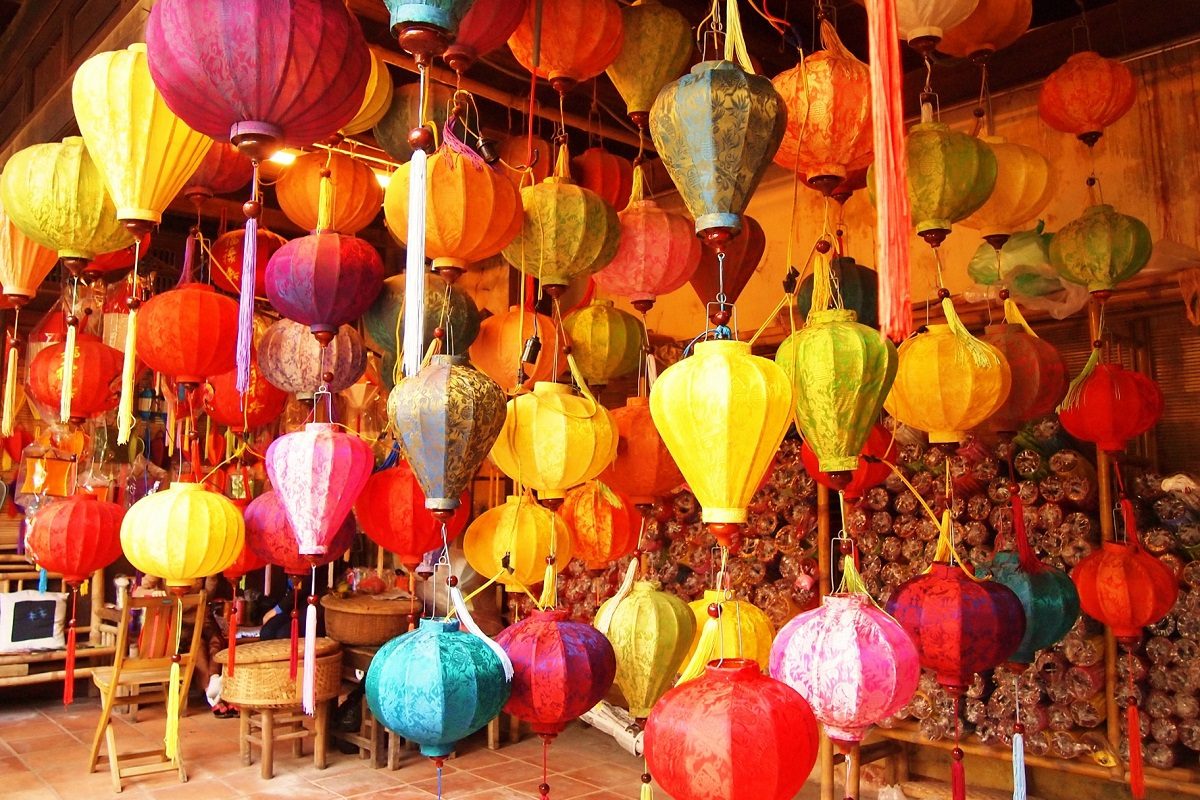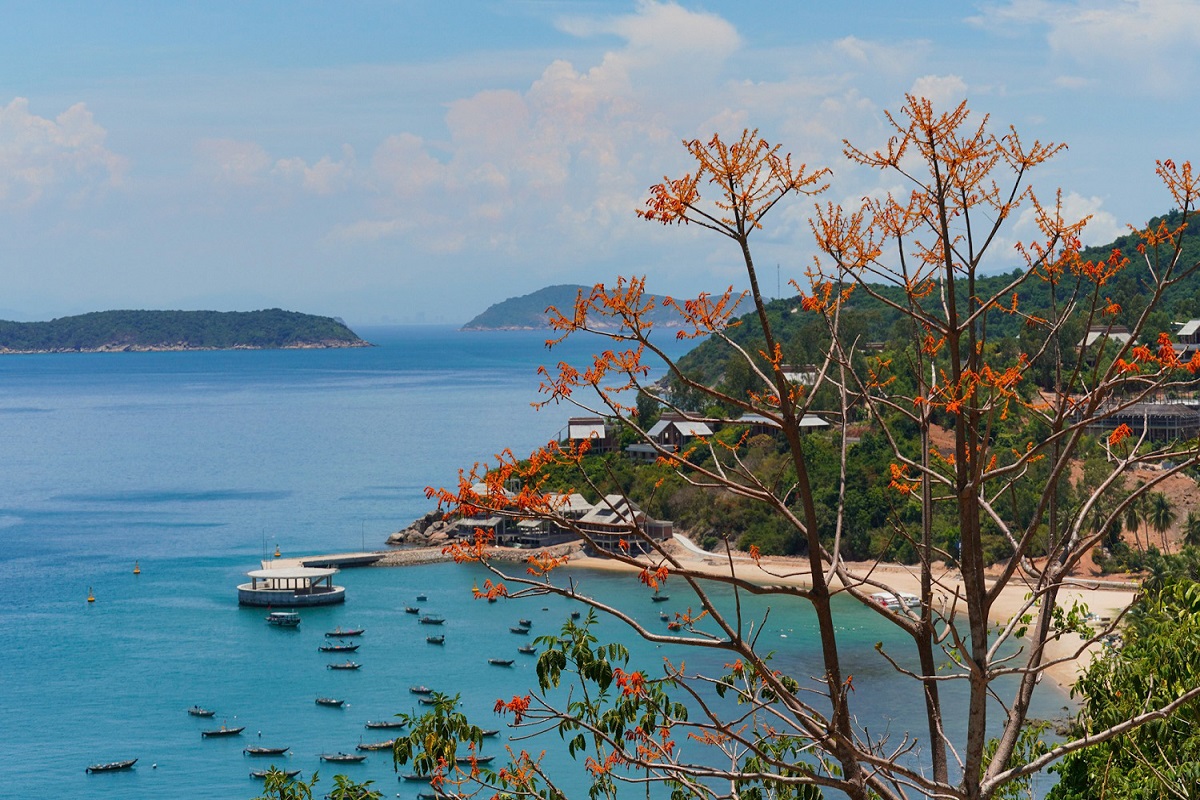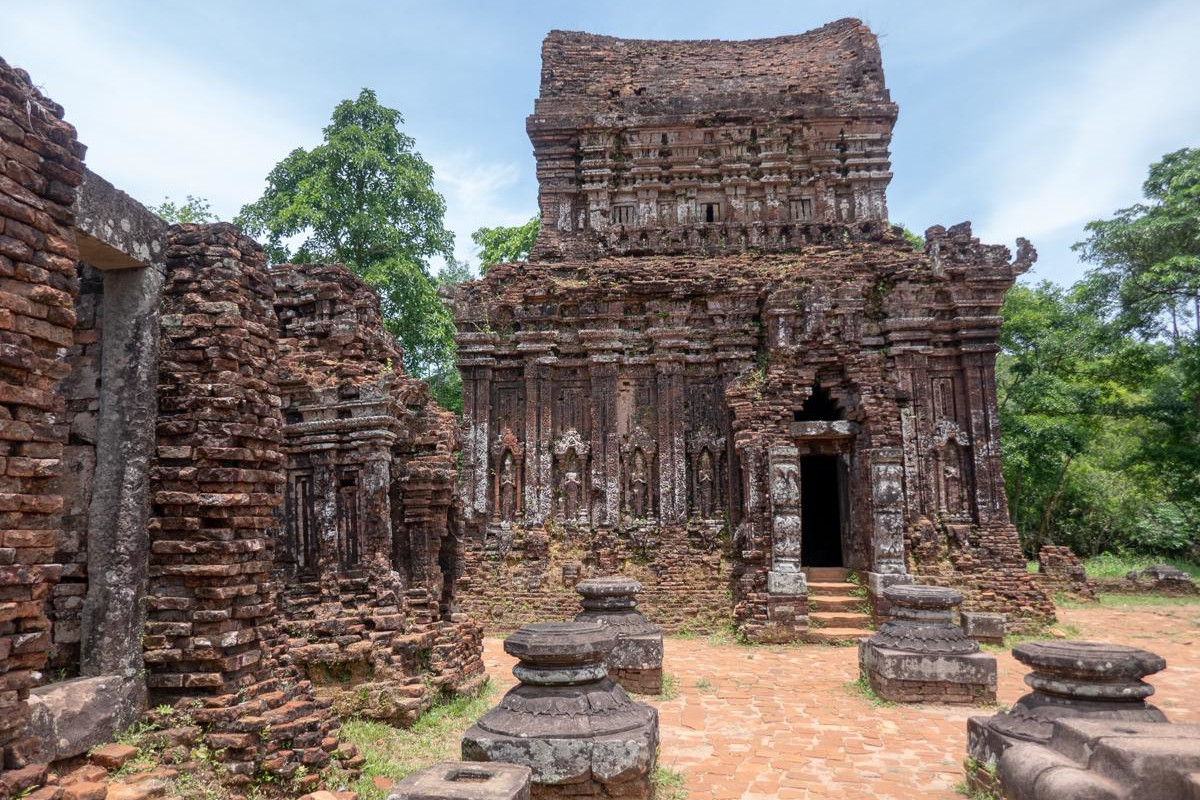Chinese people migrated to Hoi An from the early 17th century. Today, Chinese communities as a whole are the second most important piece to form the town’s unique culture. The foremost community, of course, is Vietnamese. The Chinese came here as merchants, because Hoi An was a thriving trading port and as political refugees due to Mongolian ruling over China (and later Manchu people). They called themselves “Minh Huong people”, meaning “Ming dynasty origins” or “Those who worship Ming dynasty ancestrals”. Existing from 14th to 17th centuries, the dynasty was the last imperial dynasty ruled by Han Chinese. Over many ups and downs, the Chinese in Vietnam once again changed their ethnic’s name to “Hoa people”. Now, Hoa people mean Vietnamese Chinese, including oversea residents.
During their history, Chinese people constructed many temples and assembly halls in Hoi An. This article focuses on these heritages. They are owned by the communities of the Chinese coming from Canton, Chaozhou, Hainan, Fujian and Gia Ung. All of these places are in coastal South China and not too far away from Vietnam. The strongest communities are Cantonese and Fujian, while the smallest one is Gia Ung.
Read also:
- Temples and Pagodas in Hoi An
- Linh Ung Pagodas
- The Marble Mountains in Da Nang
- My Son Sanctuary Traveler Guide

Table of content
- 1 Fujian Assembly Hall
- 2 Cantonese Assembly Hall
- 3 Chaozhou Assembly Hall
- 4 Hainan Assembly Hall
- 5 All-Chinese Communities Assembly Hall
- 6 Quan Cong Temple
- 7 Tuy Tien Duong Minh Huong (Chinese Ancestral Temple)
- 8 Ba Mu Temple
- 9 Guided Hoi An History Tour
- 10 Related Posts
- 11 Bach Ma National Park: Hiking, Trekking in Da Nang and Hoi An
- 12 Hoi An Wet Season: What to Do in Hoi An When It Rains?
- 13 Thanh Ha Terracotta Park
- 14 Vinwonders Nam Hoi An Theme Park (formerly Vinpearl Nam Hoi An)
- 15 Am Phu Cave (Hell Cave) – Things to Do in Da Nang
- 16 Hoi An or Hue: Which is Better?
- 17 The Official Hoi An Travel Guide (MUST READ)
- 18 The Hoi An Market (Hoi An Central Market) Complete Guide
- 19 Hoi An Memories Show: The Best of Hoi An Impression Theme Park
- 20 Hoi An Bridge: Famous Bridges in Hoi An
- 21 How to Get From Hoi An to My Son Sanctuary
- 22 Hoi An’s Chinese Assembly Halls and Chinese Temples
- 23 Hoi An Walking Tours: Heritage, Foods, Photography & Locals
- 24 Hoi An Self Guided Walking Tour – Hoi An On Your Own
- 25 How to Visit Golden Bridge Vietnam
- 26 Unique Experiences in Hoi An and Why?
- 27 An Bang Beach: A Guide to Hoi An’s Best Beach
- 28 Experiences in Hoi An: Get Insight Into Hoi An’s Local Culture
- 29 Things to Do in Ba Na Hills Besides Golden Bridge
- 30 Hoi An Nightlife: What to Do in Hoi An At Night?
- 31 Hoi An Countryside: Villages, Rice Fields & Tours
- 32 How to Get to Golden Bridge From Hoi An
- 33 Hoi An Entrance Fee: Old Town, Golden Bridge, My Son, More
- 34 Hoi An Airport: Everything You Need to Know
- 35 Hoi An Lantern Boat Ride on Hoai River
- 36 Hoi An Private Car and Driver
- 37 What to Do in Hoi An Ancient Town
- 38 Da Nang and Hoi An Itinerary for Visitors Staying Overnight in Hoi An
- 39 Hoi An 3 Day Itinerary: A Travel Plan for 3 Days in Hoi An
- 40 Hoi An Free Things to Do: Budget Travel in Hoi An Vietnam
- 41 Hoi An One Day Itinerary: A Travel Plan for One Day in Hoi An
- 42 Hoi An Half-Day Tours: Guide to Half Day Trips From Hoi An
- 43 Hoi An Day Tours: A Guide to Best Day Trips From Hoi An
- 44 Hoi An Beach: A Guide to All Beaches in Hoi An Vietnam
- 45 Hoi An Food Specialties
- 46 How to Get From Hoi An to Da Nang
- 47 Hoi An Cheap Things to Do: All Solo Travelers Need to Know
- 48 Hoi An Best Things To Do: Recommendations from Local Experts
- 49 Hoi An Things to Do: All What Can You Do in Hoi An Vietnam
- 50 Hoi An Things Not to Miss: A Guide to Must Do in Hoi An
- 51 Hoi An or Da Nang: Which is Better for First Time Visitor?
- 52 Hoi An Pottery Village: A Guide to Thanh Ha Pottery Village
- 53 Hoi An Ancient Town Tour
- 54 Hoi An Old Town Ticket: Price, Sellers, Included Sites, More
- 55 My Son Sanctuary Tour
- 56 Hoi An Lanterns: Festival, Making Class, Where to Buy, More
- 57 Hoi An Best Area to Stay: Guide to Where to Stay in Hoi An
- 58 Hoi An Weather by Month: Guide to Hoi An Monthly Weather
- 59 Hoi An River Cruise: Guide to The Best Boat Tour in Hoi An
- 60 Hoi An Old Town Boats: Guide to Boat Rides in Hoi An Town
- 61 Hoi An 2 Day Itinerary: Traveler Guide to 2 Days in Hoi An
- 62 Cham Island Hoi An
- 63 Hoi An Basket Boat Ride
- 64 Hoi An Coconut Village: A Guide to Cam Thanh Coconut Village
- 65 Hoi An Cham Temples: My Son Sanctuary & Quang Nam Temples
- 66 How to Get from Da Nang Airport to Hoi An
- 67 Da Nang to Hoi An: Best Da Nang Airport Transfer and More
- 68 Hoi An Tour Guide: How to Find a Private Tour Guide in Hoi An
- 69 Hoi An Ancient Town Attractions
- 70 Hoi An Old Town Map
- 71 Tra Que Vegetable Village
- 72 Guide to Hoi An Lantern Festival – Hoi An Full Moon Festival
- 73 Hoi An Night Market: A Thing to Do in Hoi An at Night
- 74 My Son Sanctuary Travel Guide
- 75 Hoi An Old Town Unesco World Heritage – Hoi An Travel Guide
- 76 Featured Tours and Experiences
- 76.0.1 Bach Ma National Park Tour from Hue
- 76.0.2 Bach Ma National Park Tour from Da Nang/Hoi An
- 76.0.3 Hoi An Sunrise Fish Market Tour
- 76.0.4 My Lai Massacre Tour
- 76.0.5 Golden Bridge/Ba Na Hills & Hoi An Tour
- 76.0.6 Hoi An Instagram Tour
- 76.0.7 Ky Anh Tunnel & Tam Thanh Mural Village Tour
- 76.0.8 Da Nang to Hue Motorbike Tour with Hai Van Pass & Easy Rider (1 Way)
- 76.0.9 Hue to Da Nang Motorbike Tour with Hai Van Pass & Easy Ride (1 Way)
- 76.0.10 Hue to Hoi An Motorbike Tour with Hai Van Pass & Easy Rider (1 Way)
- 76.0.11 Hoi An to Hue Motorbike Tour with Hai Van Pass & Easy Rider (1 Way)
- 76.0.12 Tra Que Vegetable Village Tour with Cooking Class
- 76.0.13 Ba Na Hills Half Day Tour from Hoi An
- 76.0.14 Marble Mountain & Hoi An Day Tour from Da Nang Port
- 76.0.15 Hue Day Tour from Chan May Port with Lunch
- 76.0.16 Marble Mountain & Hoi An Tour from Chan May Port
- 76.0.17 Ba Na Hills/Golden Bridge Tour from Da Nang Port
- 76.0.18 Ba Na Hills/Golden Bridge Tour from Chan May Port
- 76.0.19 Golden Bridge Private Tour with Ba Na Hills & Lunch
- 76.0.20 Ba Na Hills Afternoon Tour with Golden Hands Bridge
- 76.0.21 Ba Na Hills Private Tour with Golden Hands Bridge
- 76.0.22 Ba Na Hills Half Day Tour with Golden Bridge
- 76.0.23 Ba Na Hills Early Morning Tour to Beat the Crowds
- 76.0.24 Golden Bridge and Ba Na Hills Night Tour
- 76.0.25 Golden Hands Bridge Tour In Sunrise or Sunset (1/2 Day)
- 76.0.26 Cam Kim Island Bicycle Tour From Hoi An
- 76.0.27 Cham Island Tour From Hoi An (Group Tour)
- 76.0.28 Cham Island Tour From Da Nang (Group Tour)
- 76.0.29 Hoi An Vegetarian Food Tour
- 76.0.30 Hoi An Evening Walking Food Tour with Local Foodie
- 76.0.31 Private Hoi An Basket Boat Tour (Shuttle Bus, Bicycle, Bike)
- 76.0.32 Half-day Am Phu Cave Tour (Private)
- 76.0.33 Hoi An Countryside Tour by Electric Car or Bike
- 76.0.34 Da Nang Tour Package From Singapore
- 76.0.35 Hoi An Evening Tour From Da Nang with Lantern Boat Ride
- 76.0.36 Hoi An Walking Food Tour Through Laneways
- 76.0.37 My Son Sanctuary and Hoi An Old Town Tour
- 76.0.38 My Son Day Trip From Hoi An including Marble Mountains and Basket Boat
- 76.0.39 Half Day Hoi An City Tour With River Cruise
- 76.0.40 Son Tra Peninsula Tour with Marble Mountains (Private/Small Group)
Fujian Assembly Hall
Fujian Assembly Hall (or Fujian Temple, Thien Hau Temple, the Goddess Temple, Hoi quan Phuoc Kien) is the largest among five Chinese assembly halls of Hoi An. Facing southwest, it’s built in 1757 in the oldest road of the town that today is called Tran Phu street. This edifice has been used for worship of Thien Hau goddess or the Goddess of sea as main deity, the Six generals, the God of wealth, the Three fairies and Twelve midwives. The biggest festival here takes place on the 23rd of the third lunar month, to commemorate Goddess’s day of death. Thanks to the richness of the community, it owns elaborate wood carvings, paintings and sculptures. See full details in Fujian assembly hall visitor guide.
Here, there are important information about the Fujian assembly hall:
– Address: 46 Tran Phu St, Minh An ward, Hoi An
– Opening hours: 8 am to 5 pm daily
– Ticket price: visitors need to buy Hoi An ancient town ticket to enter. It’s impossible to pay directly to locals to visit. Besides this assembly hall, they can go to 4 other places or see the performances at 66 Bach Dang St theatre.
– Dresscode: the community requires visitors to wear respectively to respect the gods and for the holiness of the temple. Shirts must cover the armpits, back, navel and are not made of see-through fabrics. Pants must be longer than knees. Traditional costumes of Vietnamese or Chinese are highly encouraged.
Cantonese Assembly Hall
Cantonese Assembly Hall (or Cantonese Temple, Hoi quan Quang Dong, Hoi quan Quang Trieu) was built in 1885 from the sponsorship of 18 Cantonese merchants. Today, it’s one of the most popular sights in Hoi An ancient town world heritage. Originally, this edifice was used to venerate Thien Hau goddess or Goddess of the sea (middle), the God of wealth (left) and ancestors (right). In 1915, Cantonese people also worship Confucius here and placed his statue in the middle. A short time later, central deities were replaced by Guan Yu, a famous Chinese military general who lived in 3rd century (the same as the Japanese bridge’s temple). The belief doesn’t change up to the present.
Here, there are important information about the Fujian assembly hall:
– Address: 176 Tran Phu St, Minh An ward, Hoi An
– Opening hours: 8 am to 5 pm daily
– Ticket price: visitors need to buy Hoi An ancient town ticket to enter. It’s impossible to pay directly to locals to visit. Besides this assembly hall, they can go to 4 other places or see the performances at 66 Bach Dang St theatre.
– Dresscode: the community requires visitors to wear respectively to respect the gods and for the holiness of the temple. Shirts must cover the armpits, back, navel and are not made of see-through fabrics. Pants must be longer than knees. Traditional costumes of Vietnamese or Chinese are highly encouraged.
Chaozhou Assembly Hall
Chaozhou Assembly Hall (Hoi quan Trieu Chau) was built in 1845 (or earlier) by Chinese people coming from Chaozhou. In 1887, 1970 and 1991, it’s embellished. Traditionally, this edifice venerates Ma Yuan or Phuc Ba Tuong Quan (meaning “the General who Calms the Waves”), a real Chinese military general living from 14 BC to 49 AD. Locals call him Ong Bon, so it’s named “Ong Bon temple” for that reason. In past centuries, merchants and sellers came here to pray, borrow some money and give back later, with an interest. The biggest festival here is on the 16th day of the first lunar month, to celebrate the spring and a new year.
After the Vietnamese, Chaozhou assembly hall was also used as a government office for locals and from 1988 to 1900, workers made wool carpets here. Today, it’s totally given back to the community, and opens for tourists.
Here, there are important information about the Chaozhou assembly hall:
– Address: 362 Nguyen Duy Hieu St, Minh An ward, Hoi An
– Opening hours: 8 am to 5 pm daily
– Ticket price: visitors need to buy Hoi An ancient town ticket to enter. It’s impossible to pay directly to locals to visit. Besides this assembly hall, they can go to 4 other places or see the performances at 66 Bach Dang St theatre.
– Dresscode: the community requires visitors to wear respectively to respect the gods and for the holiness of the temple. Shirts must cover the armpits, back, navel and are not made of see-through fabrics. Pants must be longer than knees. Traditional costumes of Vietnamese or Chinese are highly encouraged.
Hainan Assembly Hall
Built in 1875 and largely embellished in 1931, Hainan Assembly Hall (or Quynh Phu Assembly Hall, Hainan Temple, Hoi quan Hai Nam) is owned by Chinese people moving from Hainan island. It has been a place to worship the 108 saints (or brothers) as protector deities for seafarers and merchants. According to history, these people traveled by boat to Vietnam and were then killed because they were thought to be pirates. In 1851, Tu Duc – the 4th king of the Nguyen dynasty understood that it’s wrong and requested to construct temples to honour them. On the 15th day of the sixth lunar month, the community organizes solemn ceremonies to commemorate them. Previously, on the 2nd day of the new year, all Hainan people in Hoi An gather here for communal activities and celebrate the spring.
Here, there are important information about the Hainan assembly hall:
– Address: 10 Tran Phu St, Minh An ward, Hoi An
– Opening hours: 8 am to 5 pm daily
– Ticket price: visitors need to buy Hoi An ancient town ticket to enter. It’s impossible to pay directly to locals to visit. Besides this assembly hall, they can go to 4 other places or see the performances at 66 Bach Dang St theatre.
– Dresscode: the community requires visitors to wear respectively to respect the gods and for the holiness of the temple. Shirts must cover the armpits, back, navel and are not made of see-through fabrics. Pants must be longer than knees. Traditional costumes of Vietnamese or Chinese are highly encouraged.
All-Chinese Communities Assembly Hall
All-Chinese Communities Assembly Hall (or the Chinese Assembly Hall, the Five communities assembly hall, Duong Thuong assembly hall) was built in the early 18th century. It has been used for communal activities of most Chinese people in Hoi An, for the small Gia Ung community and for worship of deities. The main deity is Thien Hau goddess or Goddess of sea because she patronizes merchants, fishermans and migrants while they’re in the boat. The God of wealth, ancestors, the Lady buddha, martyrs, two door gods (“Thousand-mile eye” and “Wind-following ear”), a sailing boat, dead leaders and vice-leaders of the entire Hoi An’s Chinese community are also venerated. In addition, this edifice also is a school where older generations teach the next ones their own cultures and languages.
Here, there are important information about the All-Chinese communities assembly hall:
– Address: 64 Tran Phu St, Minh An ward, Hoi An
– Opening hours: 8 am to 5 pm daily
– Ticket price: visitors need to buy Hoi An ancient town ticket to enter. It’s impossible to pay directly to locals to visit. Besides this assembly hall, they can go to 4 other places or see the performances at 66 Bach Dang St theatre.
– Dresscode: the community requires visitors to wear respectively to respect the gods and for the holiness of the temple. Shirts must cover the armpits, back, navel and are not made of see-through fabrics. Pants must be longer than knees. Traditional costumes of Vietnamese or Chinese are highly encouraged.
Quan Cong Temple
In the front of the Hoi An central market, Quan Cong Temple (or Ong Temple, Chua Ong) was founded in 1653 (or earlier) to worship Quan Cong. He is an esteemed Chinese military general who lived in 3rd century, representing royalty, integrity, sincerity and justice. For that reason, merchants often visit him to pray for luck, swear or guarantee something when they have business deals. On 24th day of the sixth lunar month, Hoi An locals come here to pray with offsprings, making long queues of prayers. They also memorize Quan Cong’s day of death.
Up to date, Quan Cong temple was embellished 7 times and the details about them were written in Mandarin, on steles on the walls. In its heart, the holiest space, the statue of Quan Cong is placed solemnly. Next to him, there is the statue of Guan Ping – his oldest son (adopted), Zhou Cang – a fictional character of the “Romance of Three Kingdoms” novel and his beloved horses (two). All were carved by local carpenters of Kim Bong village.
Behind the temple, visitors can see the Quan Am pagoda or “Lady Buddha/Quan Yin pagoda”. For merchants, the Lady Buddha is their protector when traveling in the sea. Shoes must be taken off if someone wants to go in and pray.
Here are there are important information about the Quan Cong temple:
– Address: 24 Tran Phu St, Minh An ward, Hoi An
– Opening hours: 8 am to 6 pm daily
– Ticket price: visitors need to buy Hoi An ancient town ticket to enter. It’s impossible to pay directly to locals to visit. Besides this assembly hall, they can go to 4 other places or see the performances at 66 Bach Dang St theatre.
Tuy Tien Duong Minh Huong (Chinese Ancestral Temple)
Established in 1725, Tuy Tien Duong Minh Huong (or the Chinese Ancestral Temple) is dedicated to worship the ancestors of Chinese people in Hoi An, particularly Minh Huong village. Worshiping characters include 10 Mans who were former officials of Ming dynasty but later quit, changed their names and went to Vietnam. Three Mans succeeded them and developed the community. Chinese also praised them as ancestors. Altars to venerate a lady of Ngo family name and Hue Hong monk are also seen.
Until now, it’s embellished 5 times. Information about each was carved in Mandarin on wooden sticks used to support the roof of the house. It has been standing at its current location in 1905. Entire temple was built by Kim Bong village’s carpenters who had the best skills at that time.
Here are there are important information about the Chinese ancestral temple:
– Address: 14 Tran Phu St, Minh An ward, Hoi An
– Opening hours: 8 am to 5 pm daily
– Ticket price: visitors need to buy Hoi An ancient town ticket to enter. It’s impossible to pay directly to locals to visit. Besides this assembly hall, they can go to 4 other places or see the performances at 66 Bach Dang St theatre.
Ba Mu Temple
Ba Mu Temple was firstly established in 1626 and then moved to its current location without clear reasons. Due to fire and wars, only its gate remains and in 2018, reconstruction works were done, giving it a new stage. This gate has a circle representing the moon in the middle and 4 entrances to both sides. Two doors allowed people to enter the shrine to the Deity of medicine and 36 generals as deities. The others open to the shrine where Thien Mau goddess (Goddess of the sea) and 12 midwives are worshipped. Both shrines will be rebuilt soon. In the front, there is a water lily pond. No matter daytime or nighttime, the Ba Mu temple’s gate is still grand and photogenic.
In 1930, French people listed Ba Mu temple with other Hoi An town’s landmarks (Japanese bridge, Quan Cong temple) as protected heritages of the Indochina federation.
Here are there are important information about the Ba Mu temple:
– Address: 675 Hai Ba Trung St, Minh An ward, Hoi An
– Opening hours: 24 hours
– Ticket price: free of charge
– Dresscode: no required
Guided Hoi An History Tour
We arrange private tours with a knowledgeable guide to allow visitors to deeper understand the history of Hoi An and communities living in it. The tours are walking, and the Hoi An old town world heritage is the host place. Of course, Chinese assembly halls and temples are included in the itinerary. Text us in whatsapp number +84968009827 or email centralvietnamguide@gmail.com for assistance.
Read also: Hoi An Private Car and Driver
Related Posts
Bach Ma National Park: Hiking, Trekking in Da Nang and Hoi An
Two best places for trekking and hiking in and near Da Nang are Son Tra mountain (peninsula) and Bach Ma national park. Which one is better is actually personal because these
Hoi An Wet Season: What to Do in Hoi An When It Rains?
No beach, no pool, no outdoor adventures? What to do in Hoi An when it rains? This is a very popular question from travelers who come to Vietnam in the
Thanh Ha Terracotta Park
Between 15th and 19th centuries, Hoi An was one of major stopovers for sailing merchants to trade in Southeast Asia. Meanwhile, craftspeople in its Thanh Ha village produce high-quality pottery
Vinwonders Nam Hoi An Theme Park (formerly Vinpearl Nam Hoi An)
In addition to historical and cultural attractions, nowadays Hoi An also has a couple of amusement parks to entertain. Definitely, they’re ideal places for families with children and groups of
Am Phu Cave (Hell Cave) – Things to Do in Da Nang
Although in the Marble mountains – the most visited attraction in Da Nang, travelers often miss Am Phu cave. One of reasons is that it’s mentioned much online and not
Hoi An or Hue: Which is Better?
Both Hoi An and Hue cities are in the middle of Vietnam, and they’re not far from each other (about 130 km). Therefore, for those who travel from north to
The Official Hoi An Travel Guide (MUST READ)
By the estuary of Thu Bon river, Hoi An is one of the best places to visit in Vietnam. This Vietnamese town is a package for travelers – a pretty
The Hoi An Market (Hoi An Central Market) Complete Guide
The Hoi An Market is the first market in Hoi An ever. Over centuries, it’s still the largest market in town although the town has a much bigger size than
Hoi An Memories Show: The Best of Hoi An Impression Theme Park
The Hoi An Memories Show is a famous series of outdoor performances in Hoi An at the present time. Thanks to its exceptional production and great cultural stories, it becomes
Hoi An Bridge: Famous Bridges in Hoi An
Hoi An has many bridges because it’s located at the confluence of 3 rivers: Thu Bon river, De Vong river and Truong Giang “Long river”. The distributaries of these rivers
How to Get From Hoi An to My Son Sanctuary
My Son sanctuary is one of the most popular places to visit for tourists staying overnight in Hoi An, especially those who spend many days there. It’s known for a
Hoi An’s Chinese Assembly Halls and Chinese Temples
Chinese people migrated to Hoi An from the early 17th century. Today, Chinese communities as a whole are the second most important piece to form the town’s unique culture. The foremost
Hoi An Walking Tours: Heritage, Foods, Photography & Locals
Strolling around heritage quarters with a local guide is the activity that so many travelers love to do in Hoi An. It enriches their time in this lovely town. Firstly,
Hoi An Self Guided Walking Tour – Hoi An On Your Own
Hoi An old town is friendly for pedestrians, especially during the time that motorized vehicles (scooters, cars, etc) are prohibited to move around its heritage quarters. That is safe for
How to Visit Golden Bridge Vietnam
The Golden Hand Bridge of Ba Na hills today is a dream place to visit for many travelers. Since it opened in June 2018, millions of people have set their
Unique Experiences in Hoi An and Why?
Today, travelers seek more experiences in the destination they go to. They want to have a deeper understanding about the culture of local people and interact with them. No other
An Bang Beach: A Guide to Hoi An’s Best Beach
An Bang beach now becomes a popular tourist attraction in Hoi An. It may be the best known and most convenient to reach from the town’s centre. Not only tourists,
Experiences in Hoi An: Get Insight Into Hoi An’s Local Culture
As the most unique Vietnamese town, Hoi An is definitely worth visiting. Here, visitors have many things to do and experiences for their holiday time. Everyone knows that it has
Things to Do in Ba Na Hills Besides Golden Bridge
According to local authorities, 50% of visitors coming to Da Nang and Hoi An visit the Ba Na hills. In other words, that is nearly 10 millions of people. This
Hoi An Nightlife: What to Do in Hoi An At Night?
After dark, Hoi An becomes exceptionally spectacular. If planning to stay overnight or visiting this ancient heritage town, at least travelers know that it’s “decorated” by so many colorful lanterns.
Hoi An Countryside: Villages, Rice Fields & Tours
By the coast, Hoi An is at the confluence of 3 rivers: Thu Bon river, Truong Giang river and De Vong river. This economically strategic location has supported trading activities
How to Get to Golden Bridge From Hoi An
There are many travelers visiting the Golden bridge from Hoi An. Both the bridge and the town today are must-see places in the region, so staying overnight in the town
Hoi An Entrance Fee: Old Town, Golden Bridge, My Son, More
Are you planning to visit Hoi An? And you don’t know how much cash you need to prepare for visiting places? This article lists tourist attractions in Hoi An and
Hoi An Airport: Everything You Need to Know
Hoi An is a famous tourist city in Vietnam. It’s 800 kilometers away from Hanoi, the capital of Vietnam and nearly 1,000 kilometers from Ho Chi Minh city, the biggest
Hoi An Lantern Boat Ride on Hoai River
A lantern boat ride is a thing to do that visitors must do today in Hoi An. For many centuries, locals have taken it on the Hoai river by the
Hoi An Private Car and Driver
Hoi An is one of the most popular tourist destinations in Vietnam. In the busiest year, it attracts about 9 millions visitors who come to enjoy its charming beauty, rich
What to Do in Hoi An Ancient Town
Hoi An Ancient Town is a must see, not only thanks to its world heritage title, but also to its vintage urban landscape, lots of attractions and activities. In the
Da Nang and Hoi An Itinerary for Visitors Staying Overnight in Hoi An
Da Nang and Hoi An are twin cities in the heart of Central Vietnam. Both are popular tourist destinations for either domestic or international visitors, and share many similarities. Due
Hoi An 3 Day Itinerary: A Travel Plan for 3 Days in Hoi An
3 days are a perfect duration to stay overnight in Hoi An and explore captivating places in and around it. Especially for those who travel from city to city or
Hoi An Free Things to Do: Budget Travel in Hoi An Vietnam
Travelers should know free things to do in Hoi An, to save the budget for this wonderful city and by that, can stay longer to explore. From old town, countryside
Hoi An One Day Itinerary: A Travel Plan for One Day in Hoi An
From a backwater town in the 1990s, Hoi An today is one of leading tourist destinations across Vietnam. In a recent year, it attracted 8,5 millions of overnight visitors and
Hoi An Half-Day Tours: Guide to Half Day Trips From Hoi An
Top attractions near Hoi An require a couple of hours or half a day, to get there and visit around. The reason is that all have many things to see,
Hoi An Day Tours: A Guide to Best Day Trips From Hoi An
Near Hoi An, there are many fantastic places making travelers can’t stay in the room and have to go out to explore. Appeal Golden bridge – the new world wonder,
Hoi An Beach: A Guide to All Beaches in Hoi An Vietnam
Not only an old town, Hoi An has beaches as well! That are sandy, edged by tropical water and lined by palm forests. Travelers don’t need to wait or move
Hoi An Food Specialties
Hoi An is a melting pot where people from different parts of Vietnam and countries in the world have gathered and exchanged their cultures. As a result, this town has
How to Get From Hoi An to Da Nang
Da Nang is the neighbouring city of Hoi An. It's the capital of Central Vietnam and has the most important (busiest) transport hubs of the region, such as airport, train
Hoi An Cheap Things to Do: All Solo Travelers Need to Know
Knowing free and cheap things to do in the city where travelers are going to visit, is helpful. First of all, they can save and, thanks to that, can stretch
Hoi An Best Things To Do: Recommendations from Local Experts
It is no coincidence that Hoi An is in the list of must-visit places once in the lifetime of many travelers. Located by a river, it’s borned to welcome people
Hoi An Things to Do: All What Can You Do in Hoi An Vietnam
Hoi An is in the bucket list of most travellers who plan to visit the Central part of Vietnam. It’s a lovely old and small town located downstream of a
Hoi An Things Not to Miss: A Guide to Must Do in Hoi An
In fact, there are so many things to do in Hoi An, one of the 10 best cities in Asia by Travel + Leisure in 2021. It has a lantern-filled
Hoi An or Da Nang: Which is Better for First Time Visitor?
Da Nang and Hoi An are located in Central Vietnam, with a distance of roughly 30 km. To the north, Da Nang is the capital city of the region, with
Hoi An Pottery Village: A Guide to Thanh Ha Pottery Village
Hoi An used to be a bustling, prosperous trade port during past centuries, before its role was replaced by Da Nang. Merchants from many countries on different continents came here
Hoi An Ancient Town Tour
Hoi An Ancient Town is a Unesco world heritage site by the mouth of the Thu Bon River. It has grid-plan streets filled by silk lanterns and bougainvillea flowers that
Hoi An Old Town Ticket: Price, Sellers, Included Sites, More
As an attraction including attractions, Hoi An Old Town requires an entrance ticket to tourists who come from other parts of Vietnam and the world. It raises funds for preservation of
My Son Sanctuary Tour
My Son Sanctuary is a Unesco world heritage site, attracting 450,000 visitors in recent years. It’s the best remains left by the fallen Champa Kingdom which ruled a part of
Hoi An Lanterns: Festival, Making Class, Where to Buy, More
Lanterns are the signature of Hoi An Old Town, the 3rd Unesco world heritage site in Vietnam. Especially at night, these traditional handicraft objects are lit up and make the town
Hoi An Best Area to Stay: Guide to Where to Stay in Hoi An
In the busiest year, nearly 5,5 millions travellers decided to stay overnight in Hoi An. It’s the largest number that a city in the Central coast of Vietnam ever achieved.
Hoi An Weather by Month: Guide to Hoi An Monthly Weather
Hoi An won the title “Asia’s leading cultural destination” recently in a reputable global travel award. It’s a pretty riverine-coastal town with an ancient root, surrounded by peaceful pieces of
Hoi An River Cruise: Guide to The Best Boat Tour in Hoi An
Hoi An town is by the left bank of the Thu Bon River, and by that, it draws plenty of merchants by sailing boat to visit and trade. Its golden
Hoi An Old Town Boats: Guide to Boat Rides in Hoi An Town
Hoi An town sits by the left bank of the Thu Bon River, the largest and most important waterway in mother Quang Nam province. It’s also near the mouth of
Hoi An 2 Day Itinerary: Traveler Guide to 2 Days in Hoi An
2 days are enough to know the highlights in Hoi An, a famous tourist destination in Central Vietnam. And for those who travel from city to city, 48 hours are
Cham Island Hoi An
The purple islands seen from An Bang or Cua Dai beaches are the Cham Islands. It’s one of the kind in the region where God bless it with fabulous beautiful
Hoi An Basket Boat Ride
Nowhere else outside of Hoi An Coconut Village, travelers can find a basket boat ride across the immense palm forests. It’s an experience that allows the passengers to know better
Hoi An Coconut Village: A Guide to Cam Thanh Coconut Village
Hoi An Coconut Village boasts of the most interlaced waterway system in the city. Four rivers encircle it and are connected together with smaller canals. Thanks to fertile alluvia and
Hoi An Cham Temples: My Son Sanctuary & Quang Nam Temples
Cham people settled in Hoi An before the Vietnamese arrived and handed it over in 14th century. Influenced by Indian culture, they called the land “Amaravati”, similar name to a
How to Get from Da Nang Airport to Hoi An
Located in the city of the same name, Da Nang airport is the nearest airport to Hoi An. So, if travelers want to see an extremely-colorful Lantern festival or try
Da Nang to Hoi An: Best Da Nang Airport Transfer and More
If traveling to Hoi An by air, train and cruise ship, visitors will come to Da Nang first and then have a transfer. The largest city of Central Vietnam holds
Hoi An Tour Guide: How to Find a Private Tour Guide in Hoi An
Most tour packages in Hoi An cover “ a guide”. He or she may be the first and closest local to the visitors, who lead the group to enjoy the
Hoi An Ancient Town Attractions
Spreading over an area of 30 hectares, Hoi An Old Town owns more than 1,100 timber buildings varying in function or type. In the oldest street, the Japanese bridge spans
Hoi An Old Town Map
There are so many things to see, do, eat and sleep in Hoi An Old Town, so the visitors often are confused while planning and exploring. Starting the research from
Tra Que Vegetable Village
Located in a prime location between two famous attractions, the Old Town and An Bang beach, Tra Que vegetable village is a featured point of interest. It’s famous for vegetable
Guide to Hoi An Lantern Festival – Hoi An Full Moon Festival
The Lantern Festival is amongst the best times to visit Hoi An. In which, visitors will immerse themselves in a shimmering world of uncounted lantern lights. When the crowds fill
Hoi An Night Market: A Thing to Do in Hoi An at Night
One of the most visited attractions in Hoi An is its night market. Because it is located right near the Old town, first-timer travelers commonly explore both top sights in
My Son Sanctuary Travel Guide
My Son Sanctuary is a complex of Hindu temples and a Unesco world heritage site from 1999. It’s 40 km away from Hoi An and 70 km to the southwest
Hoi An Old Town Unesco World Heritage – Hoi An Travel Guide
Situated 30km south of Da Nang, Hoi An ancient town is one of the best attractions in Central Vietnam. It is titled as the prettiest town of the country and



